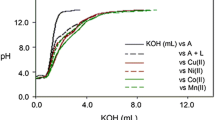Conclusions
-
1.
Exchange equilibria of the metal-proton and metal-metal type were studied by the method of IR spectroscopy in a series of substituted phenols and their C6H5Hg and (C6H5)3Sn derivatives.
-
2.
The polar effects of substituents in the phenol ring change the position of an equilibrium of the metal-proton type and practically do not influence an equilibrium of the metal-metal type.
-
3.
Depending on the nature of the acceptor of the unshared electron pair, the strength of the intramolecular coordination bond with o-halogens increases in the series: (C6H5)3Sn< H< C6H5Hg.
-
4.
The C6H5Hg group is a milder Lewis acid than (C6H5)3Sn.
-
5.
The differences in the strength of the chelate rings with the participation of the (C6H5)3Sn group and the H-atom of hydrogen increases sharply for six-membered rings formed by NO2 and CHO groups.
Similar content being viewed by others
Literature cited
V. K. Pogorelyi and I. P. Gragerov, Uspekhi Khimii,39, 1856 (1970).
L. L. Murrell and T. L. Brown, J. Organometal. Chem.,13, 301 (1968).
U. Folli, D. Jarossi, and F. Taddei, J. Chem. Soc. Perkin Trans., II, 1284 (1973).
R. J. Klyne and L. F. Sytsma, Inorg. Nucl. Chem. Letters, 8, 1(1972).
D. A. Armitage and A. Farascoli, Inorg. Nucl. Chem. Letters,9, 1225 (1973).
A. W. Baker and A. T. Shulgin, Canad. J. Chem.,43, 650 (1965).
A. N. Nesmeyanov, D. N. Kravtsov, É. I. Fedin, B. A. Kvasov, V. M. Pachevskaya, and L. S. Golovchenko, Dokl. Akad. Nauk SSSR,183, 1098 (1968).
D. N. Kravtsov, B. A. Kvasov, L. S. Golovchenko, E. M. Rokhlina, and E. I. Fedin, J. Organometal. Chem.,39, 107 (1972).
R. J. Klyne and L. F. Sytsma, J. Organometal. Chem.,54, 15 (1973).
D. N. Kravtsov, A. S. Peregudov, E. M. Rokhlina, and L. A. Fedorov, J. Organometal. Chem.,77, 199 (1974).
M. T. Tribble and J. G. Traynham, J. Amer. Chem. Soc.,91, 379 (1969).
A. J. Bloodworth, J. Chem. Soc., C, 2051 (1970).
A. N. Nesmeyanov, D. N. Kravtsov, B. A. Kvasov, and E. M. Rokhlina, V. M. Pachevskaya, L. S. Golovchenko, and E. I. Fedin, J. Organometal. Chem.,38, 307 (1972).
J. D'Ans and H. Gold, Chem. Ber.,92, 3076 (1956).
Y. Kakiuti, T. Shimozawa, and R. Suzuki, J. Molec. Spectroscopy,23, 388 (1967).
Author information
Authors and Affiliations
Additional information
Translated from Izvestiya Akademii Nauk SSSR, Seriya Khimicheskaya, No. 11, pp. 2447–2453, November, 1975.
Rights and permissions
About this article
Cite this article
Épshtein, L.M., Dau, Z.F., Pachevskaya, V.M. et al. IR-Spectroscopic investigation of exchange equilibria in substituted phenols and their organomercury and organotin derivatives. Russ Chem Bull 24, 2334–2339 (1975). https://doi.org/10.1007/BF00921643
Received:
Issue Date:
DOI: https://doi.org/10.1007/BF00921643




